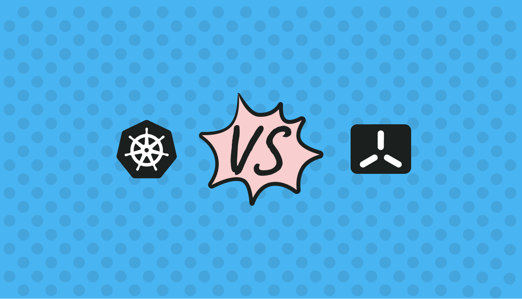K3s vs. K8s: Breaking Down the Differences and Deciding When to Use Each One

Kubernetes has become the go-to choice for managing containerized apps with ease. But let's face it, as much as we love the power and flexibility K8s bring to the table, it can sometimes be overwhelming. Let’s introduce K3s: designed to deal with edge computing, IoT devices, or streamlined CI/CD pipelines.
In this blog post, we’ll explore the differences between K3s and K8s guiding you to choose the right container orchestration solution for your specific needs.
Understanding Kubernetes (K8s)
Kubernetes is the most popular open-source container orchestration platform. It is designed to eliminate many of the manual processes involved in deploying and scaling containerized applications. However, its robustness comes with complexity. Setting up a K8s cluster involves configuring multiple components, including etcd, kube-apiserver, kube-scheduler, and kube-controller-manager, among others. This complexity, while offering flexibility and power, can be a barrier to entry for smaller projects or teams without significant DevOps resources.

Introducing K3s: The Lightweight Kubernetes
K3s is a lightweight, certified Kubernetes distribution designed to make Kubernetes accessible and efficient in resource-constrained environments. It retains all the core capabilities of Kubernetes while simplifying installation and operation. With a compact binary size of under 100MB, K3s reduces dependencies and streamlines the setup process, making it an excellent choice for production workloads in remote, unattended locations, edge computing scenarios, and IoT deployments. It has earned certification from the Cloud Native Computing Foundation (CNCF), ensuring compatibility and adherence to Kubernetes standards.

Key Differences Between K3s and K8s
- Size and efficiency: K3s offers a significantly reduced footprint, both in terms of disk space and memory usage, making it ideal for environments with limited resources.
- Simplicity in installation and operation: K3s simplifies cluster setup with a single binary installation, making it accessible for smaller teams or projects with limited Kubernetes expertise.
- Removed features: K3s removes certain features and plugins that are often unnecessary for its target use cases, focusing on core functionalities required for edge computing, IoT, and CI/CD pipelines.
- Built-in tools: K3s includes additional components like a local storage provider, a service load balancer, a Helm controller, and simplified network configuration, which help streamline operations in its intended environments.
When to Use K8s
K8s is best suited for larger, more complex applications that require the full flexibility and features of Kubernetes. It's the go-to choice for enterprise-grade environments where the scalability, security, and robust networking capabilities of Kubernetes can be fully leveraged. Use K8s when you need:
- High scalability and multi-tenancy support- K8s is perfect for dynamic environments where secure multi-tenancy is crucial, making it ideal for large-scale operations.
- Extensive integration with cloud services- For organizations that leverage various cloud services, K8s offers extensive integration capabilities. It seamlessly connects with cloud storage, databases, and networking services, providing a cohesive environment for managing cloud-native applications.
- Advanced deployment strategies and dynamic scaling- K8s supports advanced deployment strategies like canary and blue-green deployments, alongside automatic scaling for high availability.
- Deep customization and complex workload management- Organizations can tailor K8s to meet specific needs, efficiently handling a wide range of applications, from microservices to complex batch processing jobs with specific resource requirements.
When to Use K3s
K3s shines in scenarios where resources are limited, simplicity is key, or rapid deployment is necessary. It's an excellent choice for:
- Edge Computing Environments: K3s It provides a lightweight Kubernetes solution for edge computing, reducing latency and bandwidth use in resource-limited environments.
- IoT Applications: K3s offers a secure and manageable clustering solution for IoT devices, efficiently running containerized apps without overburdening hardware.
- CI/CD Pipelines: K3s is Ideal for CI/CD pipelines, K3s offers rapid spin-up times and straightforward configuration, accelerating development cycles and enabling faster application deployment.
- Small to Medium-Sized Projects: For smaller teams or projects not requiring full Kubernetes features, K3s offers accessibility and efficiency, leveraging container orchestration benefits without the complexity of a full K8s cluster.
Finout for Kubernetes
Finout revolutionizes Kubernetes cost management by providing a suite of essential tools for efficiency and savings. With intuitive cost visualization, waste detection, and resource allocation optimization, Finout empowers Kubernetes users to make informed decisions and reduce spending. It simplifies cost allocation for teams and projects, automates resource scaling based on workload demand, and seamlessly integrates into existing Kubernetes environments. In the ever-evolving Kubernetes landscape, Finout is a go-to solution for organizations seeking to optimize their containerized environments, ensuring resources are utilized efficiently while maintaining peak performance.
Conclusion
Choosing between K3s and K8s depends on your project's scale, complexity, and resource availability. K8s is unmatched in its scalability and flexibility for large-scale, complex applications. In contrast, K3s offers a streamlined, efficient alternative for edge computing, IoT, and scenarios where simplicity and resource conservation are paramount. By understanding the strengths and limitations of each, you can select the most appropriate tool for your specific needs. Whether you opt for K3s or K8s, tools like Finout for Kubernetes empower you to optimize your containerized environments and make efficient use of resources, ensuring success in this dynamic landscape.







